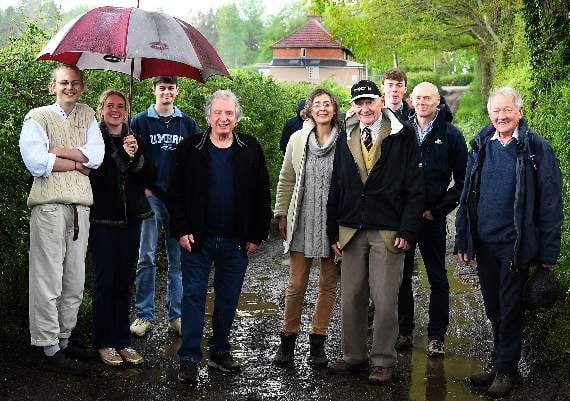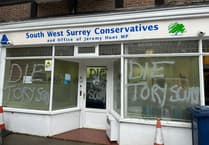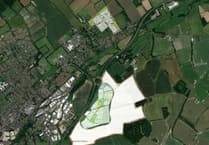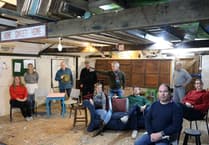With lockdown easing recently, it was great that many of those involved in tracing the details of the Vickers Virginia that force-landed in Old Park, Farnham, more than 90 years ago could finally meet up on May 22.
Despite the intermittent heavy showers, Glenn Honey, son of pilot Frank Ted Honey, and members of his family met Mick Bradford, Nick Hughes and Allan Arthurs at Bill McCall’s Old Park Farm for the short walk down the lane to Woodside Cottages, crossing the flight path of the aircraft on that day March 27, 1931, as it made its unexpected landing in Brick Kiln Lane (today’s Middle Old Park Lane).
From Woodside Cottages it was a short walk in the rain to reach the spot where the great bomber finally came to rest.
In the photograph Glenn (in cap) is surrounded by members of his family with Nick Hughes (extreme right) and Mick Bradford to Glenn’s right. Unfortunately Glenn’s brother Roger, in America could not join the gathering,
Beyond lies Woodside Cottages echoing the photograph published all those years ago in the Sphere (also pictured).
Mr Bradford then related the details of how he thought the fateful flight had progressed that day which I think is worth sharing here, finally making sense of the events leading up to what was, under the circumstances, a miraculous landing from which everybody walked away unscathed.
Vickers Virginia Night Bomber J7129 of No. 9 Sqn, Boscombe Down, forced landing at Middle Old Park, Farnham, March 27, 1931
At 12 noon on Friday, March 27 1931, with the varnish on the whirring propeller blades catching the light from the hazy sun, Sgt Frank Ted Honey turned Vickers Virginia J7129 into the light wind, opened up the two 500hp Napier Lion engines to full power and, in a tremendous cacophony of motor noise and potency, lifted the giant biplane into the air from the grassy meadow of RAF Hawkinge, crossed the Canterbury road and headed in the general direction of Dover.
Once established in the climb, he turned back towards the airfield and set course for his first waypoint, the railway hub town of Ashford, some 12 miles to the west. Beside him in the open cockpit sat his friend and colleague, Sgt William Allen, co-pilot and navigator for the flight, and behind them in the wireless operator’s position between the wings was Aircraftsman (A/C) Fred Roach.
As Sgt Honey climbed to his pre-determined altitude, a factor which would affect the flight became apparent. The south east of England was locked in an anticyclonic col, with the consequent temperature inversion causing very poor, fog-like visibility at lower levels. He noted the figures in his logbook: At 4,000ft it was little more than three miles, at 2,000ft 1,000 yards and even less at 1,000ft. With no visible horizon, flying and navigating the inherently-unstable Virginia would be arduous and tricky.
The Virginia was essentially a First World War Vimy bomber, extended and much-modified to carry more bombs and defensive guns. In fact, due to its troublesome flight characteristics, Britain’s very first autopilot was designed and built at Farnborough around the Virginia. But it is unlikely the autopilot was fitted to J7129 at this time.
At the Virginia’s cruising speed of around 75mph, it should have taken just over an hour and 40 minutes to reach Boscombe Down.
Once over Ashford, Sgt Honey would have been grateful for the long straight railway line which he could follow to Guildford with added guidance from the North Downs ridge. From there he would track the Hogs Back to Farnham, continuing on the same heading to Basingstoke, from where he could follow either the railway line or the Exeter Road to Andover and finally to Boscombe.
Such routes were tried and tested. These were the days before radio navigational aids had been established, so following a line feature, particularly in bad visibility, reduced the workload of pilot and navigator.
The flight as far as Guildford was uneventful but serious trouble began between Shalford railway junction and Puttenham – in the general area of Compton. Although Sgt Honey and the crew could not have possibly known it at the time, the port engine propeller shaft extension had failed.
It would have been very difficult for them to work out what was wrong, since the engine was running relatively normally and the propeller was turning. It was, in reality, delivering no thrust, simply windmilling in the air flow.
Apart from perhaps a surge in rpm, the first indication that anything was wrong would have been a progressive loss of speed and height, as well as a tendency to crab to port due to the asymmetric power now coming from the starboard engine. Sgt Honey would have applied more power and used the elevators to compensate for the height loss, unfortunately slowing the aircraft further.
With half the power gone, the enormous drag of this behemoth would handicap the remainder of the flight. At this stage, it would not have been obvious that a forced landing might be necessary.
With the roar of the engines only feet from the cockpit, neither pilot would have been able to detect any undue noise which might have alerted them to the source of the trouble, and they would have been kept frenetically busy trying to work out what was wrong and trying to rectify it, all the time having to fly and keep the aircraft on track through increasing gloom, while in a gradual but unavoidable descent.
The original cause was most probably a worn bearing which eventually overheated and seized, causing the prop shaft extension to shear.
By this time they had arrived over Badshot Lea, with the built-up areas of Farnham and Aldershot on each side and the rising ground of Upper Hale ahead. The altitude had fallen to below 2,000ft, so it must have become clear that some kind of unscheduled landing was inevitable. Seen through the hindsight lens of 2021, Farnborough aerodrome, five miles to the North West, would seem an obvious choice of diversion, but to get there meant crossing the heavily-populated town of Aldershot, which presented a considerable risk to civilian life. In 1931, mechanical failure was an omnipresent danger in aviation; should the remaining engine fail, the consequences didn’t bear thinking about.
Beyond the village of Upper Hale the map showed open farmland, and beyond that, equidistant to Farnborough, was a temporary landing ground at Stapely Down – now RAF Odiham. And, having passed Aldershot, they would at least have the option of diverting to Farnborough over open country.
Once they were past Upper Hale, above the crest of Folly Hill, these options evaporated. The height of J7129 above the ground had dwindled to less than 1,000ft. Ironically, both airfields lay just four miles away, yet now neither could be safely reached. A decision had to be made, and soon.
As far as could be seen, the ground ahead was unforgiving, gorse-ridden heath, and turns to starboard would be difficult due to the asymmetric thrust.
By sheer good fortune, the benign-looking green meadows of Farnham Old Park appeared out of the murk just off to port. It looked like Ted Honey’s best chance and he took it. The tree lines and shallow valleys would have naturally guided him towards Middle Old Park as there were very few suitable alternatives in sight.
Approaching the field from the north west, with visibility down to half a mile, Sgt Honey selected his field, coming in diagonally from the top corner. Committed, he cut the remaining throttle and switched off the fuel and ignition. He had found a reasonable gap between the trees and, as closely as he could judge, lined up J7129 into wind.
The big Handley Page slats on the top wing would have reduced the stalling speed and allowed him to touch down at around 50mph.
With the tail skid digging into the turf, the Virginia should have slowed to a stop in a couple of hundred yards or less. However, barely detectable from the air, the field was on a slope, with a slight gully and dip leading down to Middle Old Park Lane, which forced the Virginia to veer from its intended landing path in that direction.
It ran into the verge and hedgerow almost halfway along the lane, crossed the road at a slight angle and when the hedge sheared off the starboard undercarriage, came to a nose-down halt about 100 yards east of Woodside Cottages just in front of a telegraph pole.
Had it not been for the slope, he would have easily made it to the far corner near to Brickfield Cottages.
Sgt Frank Ted Honey was 22 years old. By any standards he did an amazing job. He had brought a crippled seven and a half ton bomber with a 90ft wingspan down safely into a tiny field with minimal damage. There is an old aviation saying that a good landing is one you can walk away from.
Three young servicemen walked away from this one and their smiling faces later pictured enjoying a picnic in the shadow of the wings is full testament to that.
Both the crew and the bomber lived to fly another day.




